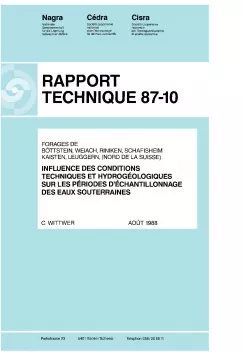
Rapport Technique NTB 87-10
Influence des conditions techniques et hydrogéologiques sur les périodes d'échantillonnage des eaux souterraines: Forages de Böttstein, Weiach, Riniken, Schafisheim, Kaisten, Leuggern (Nord de la Suisse)
The hydrogeological research programme carried out by the National Cooperative for the Storage of Radioactive Waste (Nagra) included more than 60 sampling campaigns of groundwaters in six deep boreholes (1.3 to 2.5 km) in northern Switzerland.
The sampling campaigns were carried out after isolating well-defined intervals of the sedimentary section and the crystalline basement using packers linked to the surface by tubing.
In order to determine the pollution of the groundwaters by the drilling fluids, two artificial tracers (uranine and mTFMBA) were added in known quantities to the drilling fluids, which consist most of the time of deionised water. The concentration of these two tracers was then measured during the whole clean-up period which precedes the sampling itself.
This report considers the parameters (duration and volume of drilling fluid loss, duration and volume of artesian flow before the tests, pumped volumes and reference concentration of the tracers in the drilling fluids) which have been recognised as playing an important role during the sampling and which influence the restitution of the tracers. To allow a quantitative study of these relationships, the duration and volume of drilling fluid loss and artesian flow were determined for each interval. The pumped volumes, measured at the surface, were corrected to obtain the actual volumes extracted from the rock. The relative concentrations of the tracers were calculated on the basis of their reference values in the drilling fluid and the background of the intervals before the tests.
Unfortunately, the compiled values do not allow quantitative conclusions to be drawn on the effect of parameters linked to the drilling activities on the evolution of the sampling periods; this is due to imprecision in field measurements and the variability of drilling conditions.
Since Bear (1979) described an analytical approach for interpreting injection tests and pumping tests in a single borehole using the restitution curve of a tracer as a function of the volume of water extracted from the rock, the data collected have been used to calculate values for hydrodynamic dispersion. Given that these calculations take into account the volume of fluid injected into the rock and that the field information is insufficient, the tracer restitution curves were integrated to give more precise values for the volumes of water injected.
Nine tests, selected because the starting conditions were adequate and sufficiently well-documented, have been considered. The values for longitudinal dispersivity for the five tests where there was no disturbance due to drilling activities vary between 0.10 and 0.27 m in crystalline rocks which are fractured and deformed (allowing a kinematic porosity of 3.3 %) and between 0.04 and 0.10 m in sedimentary rocks (kinematic porosity 5 to 10 %).
Despite this interpretation method being based on the hypothesis of a porous medium with radial planar flow (without molecular diffusion), and the fact that the majority of the tests were carried out in a fractured medium, the results obtained are comparable with the literature data.
A simplified calculation of the distance covered by the tracers indicates values in the order of 1 to 2 m for sedimentary rocks; in fractured rocks, the distances are between 3 and 50 m and more. These results show that the calculations of longitudinal dispersivity provide an opportunity of showing up the problems associated in interpreting this type of test but that the values themselves are only indicative and should not be used for future calculations.
